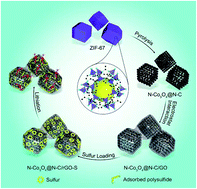MOF-derived porous N–Co3O4@N–C nanododecahedra wrapped with reduced graphene oxide as a high capacity cathode for lithium–sulfur batteries†
Abstract
The lithium–sulfur (Li–S) battery has been regarded as a highly promising rechargeable energy-storage system due to its high energy density of 2567 W h kg−1. However, moderating the dissolution of lithium polysulfides (LiPSs) and enhancing the conductivity of the sulfur cathode are the main limitations for its successful application. Herein, we demonstrate an approach to simultaneously tackle these two barriers by designing a porous N–Co3O4@N–C nanododecahedral composite. This composite was derived from ZIF-67 via a facile pyrolysis method, which realizes the effective doping of nitrogen into both Co3O4 and the carbon framework, simultaneously achieving a well-defined porous structure. After wrapping with reduced graphene oxide (rGO), this porous N–Co3O4@N–C/rGO cathode supported a high sulfur loading (5.89 mg cm−2) and exhibited excellent stability (611 mA h g−1 at 2C after 1000 cycles). Furthermore, ex situ Raman spectroscopy, ex situ X-ray photoelectron spectroscopy, UV-vis absorption spectroscopy and first-principles calculations confirm that the N–Co3O4@N–C/rGO nanododecahedra effectively bind LiPSs in the electrode over multiple cycles. This proved that the cobalt oxides in the porous N–Co3O4@N–C nanododecahedra have strong affinity for binding LiPSs. The simultaneous doping of nitrogen both into the cobalt oxides and carbon framework not only strengthened the binding energy for LiPSs absorption, but also improved the overall conductivity of the nanododecahedra. Moreover, the interconnected porous structure contributes to the electron transfer and alleviates the volume changes of active materials during cycling.

- This article is part of the themed collection: International Year of the Periodic Table: Elements for Next Generation Batteries


 Please wait while we load your content...
Please wait while we load your content...